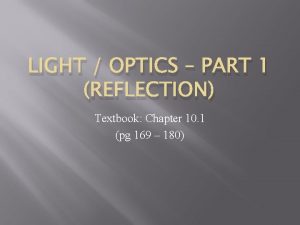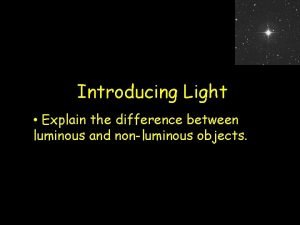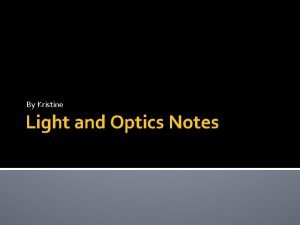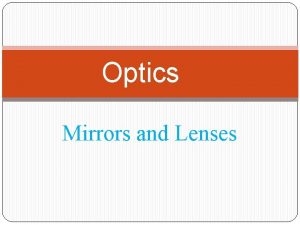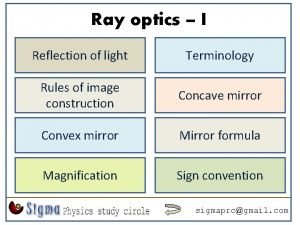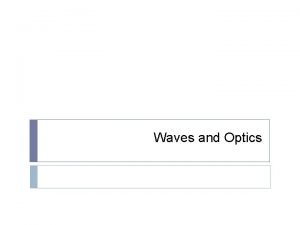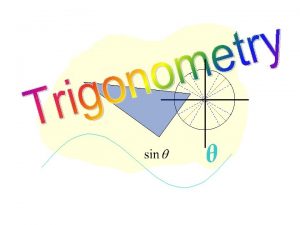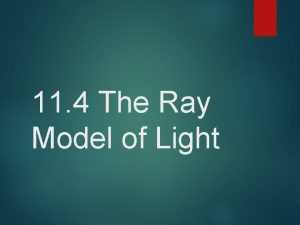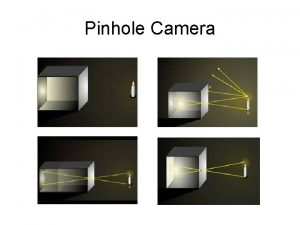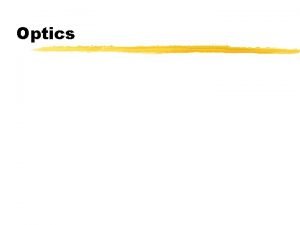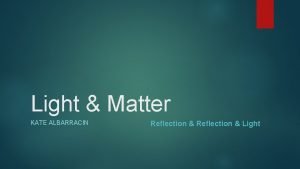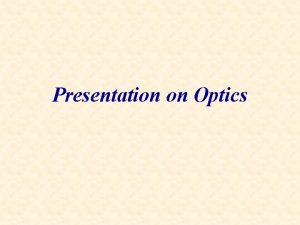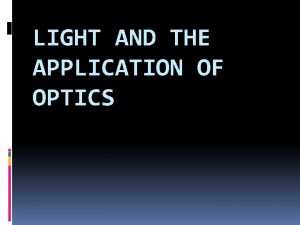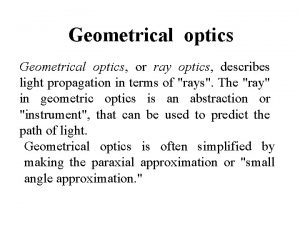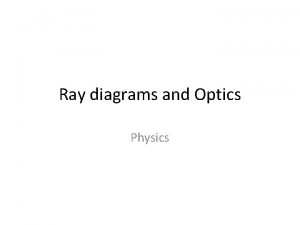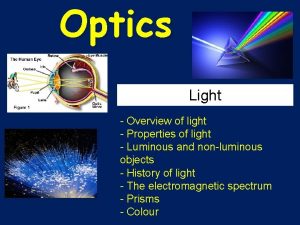Ray optics I Reflection of light Terminology Rules

















- Slides: 17

Ray optics – I Reflection of light Terminology Rules of image construction Concave mirror Convex mirror Mirror formula Magnification Sign convention sigmaprc@gmail. com

Reflection of light Laws of reflection Angle of incidence is equal to angle of reflection Incident ray, reflected ray and the normal to the point of incidence – lie in the same plane. sigmaprc@gmail. com

Spherical mirrors Terminology centre of curvature Radius of curvature Pole of the mirror R F Focal point f Principal axis Focal length sigmaprc@gmail. com

Spherical mirrors In case of mirrors, radius of curvature is always twice the focal length. This relation is valid for MIRRORS ONLY ( not for lenses ) sigmaprc@gmail. com

Spherical mirrors Rules* of construction of images An incident ray parallel to the principal axis, upon reflection, passes through the focal point of concave mirror. An incident ray passing through the focal point, upon reflection, becomes parallel to the principal axis An incident ray passing through the centre of curvature is reflected along the same path. A ray incident on the pole of the mirror is reflected making the same angle w. r. t. the principal axis. * though called “ rules” the above mentioned choice of rays is just a matter of convenience. Any ray incident of a mirror would follow laws of reflection. sigmaprc@gmail. com

Real and virtual ( objects and images ) real object real image virtual object virtual image Real object : incident rays diverge away from a real object Virtual object : incident rays converge towards a virtual object Real image : rays converge to a point after reflection Virtual image : rays diverge away from each other after reflection. Extension of reflected rays converge at a point. sigmaprc@gmail. com

Concave mirror forms both real and virtual images Focal length of a concave mirror is negative. Concave mirror always tends to converge a beam of light. Real image of a real object is always inverted. It may be enlarged or diminished or of the same size ( depending on the object distance ) Virtual image of a real object is always erect and enlarged. Note: Erect or inverted nature of an image is always w. r. t. object sigmaprc@gmail. com

Convex mirror Image of a real object is always virtual erect and diminished. Focal length of a convex mirror positive. Convex mirror always tends to diverge a beam of light. Note: Erect or inverted nature of an image is always w. r. t. object sigmaprc@gmail. com

Spherical mirrors Mirror formula and magnification This general relation and is applicable to any mirror with suitable sign convention Object distance : u Image distance : v Focal length : f u f C F v P sigmaprc@gmail. com

Spherical mirrors Lateral magnification These are general relations and are applicable to any mirror with suitable sign convention Object distance : u Object height : h Image distance : v Image height : H Positive value of magnification implies that the image is virtual Negative value of magnification implies that the image is real If m > 1 it implies that the image is magnified If m < 1 it implies that the image is diminished sigmaprc@gmail. com

Spherical mirrors New Cartesian sign convention Pole is taken as reference for position (origin) and incident ray is taken reference for direction. +ve : height measured incident ray -ve : distance measured opposite O to the direction of incident ray above principal axis +ve : distance measured in the direction of incident ray -ve : height measured below principal axis sigmaprc@gmail. com

Spherical mirrors sign convention Examples : 5 cm 15 cm P 6. 2 cm 3. 1 cm Focal length : negative Object distance Image distance Object height Image height = - 15 cm = - 6. 2 cm = + 5 cm = - 3. 1 cm sigmaprc@gmail. com

Spherical mirrors sign convention Examples : 8. 1 cm 5 cm P 3 cm 4. 2 cm Focal length : negative Object distance Image distance Object height Image height = - 3 cm = + 4. 2 cm = + 5 cm = + 8. 1 cm sigmaprc@gmail. com

Spherical mirrors sign convention Examples : 5. 2 cm 7 cm P 3 cm 4. 2 cm Focal length : positive Object distance Image distance Object height Image height = - 3 cm = + 4. 2 cm = + 7 cm = + 5. 2 cm sigmaprc@gmail. com

Revision checklist Concepts Laws of reflection Derivation of R = 2 f Derivation of mirror formula Numericals based on Determination of v and nature of image due to reflection from a single mirror Determination of magnification for given object distance and size. Determination of shape of an extended object. Determination position of image due to two successive reflections. sigmaprc@gmail. com

Note on problem solving Problems in reflection of light from spherical ( or plane ) mirrors can be solved by using the general relations ( with suitable sign conventions as and when required ). For reflections from more than one mirror, consider one reflection at a time. Use sign convention for that reflection considering pole as origin and direction of light ray incident on it for positive direction. Image formed due to one reflection acts as a object for the next reflection ( and so on ). sigmaprc@gmail. com

sigmaprc@gmail. com
 Difference between ray optics and wave optics
Difference between ray optics and wave optics Venn diagram of geometric optics and physical optics
Venn diagram of geometric optics and physical optics Bill nye light optics worksheet
Bill nye light optics worksheet Difference between luminous and non luminous objects
Difference between luminous and non luminous objects Bill nye light energy
Bill nye light energy Light and optics notes
Light and optics notes Light light light chapter 23
Light light light chapter 23 Into the light chapter 22
Into the light chapter 22 Chapter 22
Chapter 22 Plano convex lens
Plano convex lens Spherical mirror terminology
Spherical mirror terminology Reflection ray diagram
Reflection ray diagram Medical terminology in radiology
Medical terminology in radiology Sin and cos in quadrants
Sin and cos in quadrants Ray ray model
Ray ray model Ray casting method in computer graphics
Ray casting method in computer graphics Reflection at plane surfaces
Reflection at plane surfaces Reflection light analogy
Reflection light analogy


